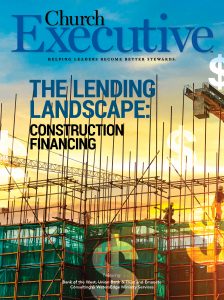
Though I’ve been blessed to work with churches for more than two decades, I learned a long time ago: never say “I’ve seen it all.”
The past year is the perfect example of why.

National Manager, Religious Institution Banking
Bank of the West
Without a doubt, 2021 provided us with new and unique challenges — but it also confirmed some emerging trends and some of the core competencies thriving organizations share, regardless of what’s going on around them.
The big get bigger
Many of the very largest churches not only survived the pandemic but thrived. It has been exciting to watch the very best continue to get better at reaching and engaging with people by adding technology and staff to focus on alternate delivery of worship and other experiences.
They’ve also seen acceleration in mergers and acquisitions of smaller congregations that were unable to adjust. Many lenders are generally unfamiliar with this growing trend of growth by acquisition. So, before entering into a long-term banking relationship, ask a lender to discuss its experience with this process; ideally, it will have walked a church client through the process before so you’re not the first.
Proximity matters for in-person events
While most of us are returning to some level of normalcy, we are more aware of our surroundings, and the value of large, in-person meetings continues to be questioned by many. As such, we’re seeing a preference emerge for smaller sites and venues versus the “one-big-room” approach.
While this is perhaps the most fascinating trend emerging, it remains to be seen what the long-term fallout for in-person social engagement will look like in the months and years ahead. Whatever happens, the role of technology in reaching a broader audience is here to stay.
Well-managed organizations win

While every state and municipality handled things differently last year during the pandemic, one through line emerged for the nonprofits I interact with: competent business management rises to the occasion. I’ve often said that most churches have a visionary communicator; but those who grow and sustain growth over time have the added layer of competent financial and business management. All of us faced new challenges over the last year, but the very best organizations were led in such a way that they were able to continue to serve their congregants with excellence and even meet new needs!
Financial partnerships matter more than ever
While the number of banks willing to consider a loan to a faith-based non-profit is high right now, the number of banks with a long-term commitment to serving the sector is at an all-time low.
Only a handful of banks have consistently served churches since before the last financial crisis. Even fewer offer a tailored approach to serving these clients with customized solutions and a long-term approach to not just the lending needs, but the full breadth of financial services a growing congregation will need, from sophisticated cash management solutions to commercial cards, merchant services, and related services.
Find a partner who understands who you are and where you want to go next and has the resources to be a catalyst, not an anchor.
Liquidity, budget margin provide options
Going into the spring of 2020, many of us had exciting growth plans and expectations for the year ahead. What we ended up with was far different — but the organizations that built cash and controlled spending are now in an incredible season of opportunity.
Having adequate cash reserves is always helpful, but those who managed this well going into the pandemic were able to make decisions with more focus on the needs of their communities and less concern for their own budget and needs. An outward focus is almost always helpful, and it was essential for greater impact over the past year.
The interest rate environment continues to be helpful for project financing, even as construction and labor costs are reaching new heights
Churches are rethinking facility needs and their approach to fundraising; but the very best ideas are still being formulated on how to creatively reach people with a timeless message in the most relevant ways possible, for the next decade and beyond.
While there might be more lenders than ever vying for your business, the very best have been here for a while and will continue to be for years to come. Don’t be afraid to ask for references from churches of similar size and congregational style to ensure the lender has the experience to serve your ministry well.
I’m excited to see what organizations who managed well through the last year do in the years ahead. With improved skill and resources to reach more people and serve their communities better than ever, the best is yet to come!
Jeremy Moore has been working with faith-based nonprofits for nearly 20 years. While working on an undergraduate degree from Lee University, he joined the US Army Reserves. He has done graduate and post-graduate work at the Stanford GSB and Northwestern University’s Kellogg School. His background includes time as a financial advisor with Merrill Lynch before joining Regions Bank as Senior Vice President, where he did his first church construction financing before moving on to exclusively serve religious institutions, developing deep industry expertise as the national sales manager for ECCU. At Bank of the West, he manages the Religious Institution Banking Team, to continue to serve large communities of faith by supporting our nationwide team of specialists.



